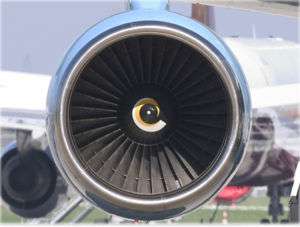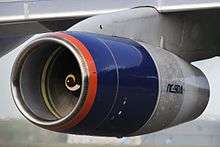Aviadvigatel PS-90
The Aviadvigatel PS-90 is a Russian high-bypass commercial turbofan rated at 16000 kgf (157 kN, 35,300 lbf) thrust. It powers Russian airliners such as the Ilyushin Il-96 and the Tupolev Tu-204/Tu-214 series and transport aircraft such as the Ilyushin Il-76. It is made by the Russian aircraft engine company Aviadvigatel, which is the successor of the Soviet Soloviev Design Bureau. "PS" are the initials of Pavel Soloviev (Russian: Павел Алеќсандрович Соловьёв).
| PS-90 | |
|---|---|
 | |
| Aviadvigatel PS-90 | |
| Type | Turbofan |
| Manufacturer | Aviadvigatel |
| First run | 1992 |
| Major applications | Ilyushin Il-96 Tupolev Tu-204 Ilyushin Il-76 |
| Number built | ~300 as of 2010 |
| Developed into | PD-14 |
Design and development
With the advent of new generation of Russian airliners, Aviadvigatel developed the PS-90 to satisfy the demands of economy, performance and exhaust emissions. It represented a huge advance over previous generations of 1960s era Soviet engines. The PS-90 is almost double the efficiency of those engines and is reasonably competitive to western engines of the 1980s such as the Pratt & Whitney PW2000.
Design features
It incorporates many firsts in a Russian engine with advanced technology features such as
- High-bypass turbofan design for economy
- Integrated exhaust with exhaust mixer for good efficiency
- Acoustically treated exhaust duct for low noise
- Full-authority digital engine control (FADEC)
- Long service life based on on-condition maintenance
- Modular design for ease of maintenance
It was first certified in 1992 and has been in service since.
Variants
There are several variants: the basic PS-90A, the PS-90A-76, and the improved PS-90A versions. The latter include the PS-90A1, PS-90A2, PS-90A-42 and the PS-90A3 engines.
PS-90A
The PS-90A engine is the initial variant and is standard equipment for Ilyushin Il-96-300, Tupolev-204-100 and the Tupolev-214. For the first time it allowed Russian airliners to achieve similar performance and economy to their western counterparts. PS-90A is rated nominally at 16000 kgf (157 kN, 35,300 lbf) thrust, 13.3% less than the original Rolls-Royce RB211-535E4 engine (which is also offered on the Tu-204), and the fuel consumption is 8.2% less than it.[1]
PS-90A-76
This variant is a modification of the basic PS-90A engine. It is rated nominally up to 14,500 kgf (142 kN, 32,000 lbf) take-off thrust.[2]
By replacing the D-30KP on the older Il-76, the service life of the aircraft can be extended. Fuel efficiency, and performance will be markedly improved and noise pollution reduced to the comply with the new strict requirements. With the large fleet of both civil and military Il-76 aircraft still in operation, a potentially large market exists for engine replacement. An example of such a modified version is the Il-76MD-90. The PS-90A-76 is the standard on the newly built, modernized versions of the Il-76, such as the Il-76MD-90A and the Il-76MF.
PS-90A1
This variant is also a modification of the basic PS-90A engine. It was certified in 2007 and is offered as an option on the IL-96-400T aircraft.[3]
PS-90A2
The PS-90A2 is an advanced derivative of the PS-90A, developed in cooperation with Pratt & Whitney.[4] It has a fair proportion of western components from France, Germany, Sweden and the USA. It is also lighter than PS-90A and features improved FADEC. These features improve the performance and reduce maintenance costs by 40%. Fuel consumption is on par with current western engines, and its noise levels are below the current regulatory requirements. The PS-90A2 is the first Russian engine to be ETOPS-180 min rated. It is offered in newly built aircraft and is completely interchangeable with the PS-90A, allowing simple upgrades on present airliners.
It has the same thrust rating as the PS-90A, 16000 kgf (157 kN, 35,300 lbf) thrust. It is also capable of 18000 kgf (176 kN, 39,600 lbf) thrust.[5]
Future American involvement in engine development has been put in doubt after unwelcome attempts to block sale of PS-90A2 engines to a major Iranian customer for the type.[6]
PS-90A-42
This is a version of the PS-90A2 intended for the Beriev A-42 search and rescue aircraft.[7]
PS-90A3
According to the manufacturer, it is a modification of the PS-90A2. It was certified in January 2011 and intended to power the Tupolev Tu-204SM aircraft.[8][9] It is unclear whether the US and Western European components of the PS-90A2 remain or whether they have been replaced by Russian ones.[10] If the US components have indeed been replaced, then this engine could be fitted to the Tu-204SM ordered by Iran Air and its subsidiaries.
Gas Turbines
- GTE-25P, GTU-25P unit
- Gas turbine PS-90GP-2 derivative of PS90A2
Specifications (PS-90A1)

Data from Aviadvigatel Perm Engine.[11]
General characteristics
- Type: Twin-spool high bypass turbofan with a single-stage fan
- Length: 4,964 mm (195.4 in)
- Fan diameter: 1,900 mm (75 in)
- Diameter:
- Dry weight: 2,950 kg (6,500 lb)
Components
- Compressor: 4-stage LP, 13-stage HP
- Combustors: Fully annular
- Turbine: 2-stage HP, 4-stage LP
Performance
- Maximum thrust: 17,400 kgf; 38,400 lbf (171 kN)
- Bypass ratio: 4.4
- Fuel consumption: 0.595 kg/kgf hour
- Thrust-to-weight ratio: 5.9
See also
Comparable engines
Related lists
References
- "PS-90А Aero Engine". www.avid.ru. Archived from the original on 2017-09-09. Retrieved 2018-05-19.
- "PS-90А-76 Aero Engine". www.avid.ru. Archived from the original on 2017-09-09. Retrieved 2018-05-19.
- "PS-90А1 Aero Engine". www.avid.ru. Archived from the original on 2017-09-09. Retrieved 2018-05-19.
- "Top Managers of Pratt & Whitney and Perm Motors Group Companies Discussed PS-90A2 Aero-Engine Development Program". avid.ru. 2007-11-15. Archived from the original on 2014-10-06.
- "PS-90А2 Aero Engine". www.avid.ru. Archived from the original on 2017-09-09. Retrieved 2018-05-19.
- "Archived copy". Archived from the original on 2011-07-24. Retrieved 2010-11-13.CS1 maint: archived copy as title (link)
- http://www.pmz.ru/eng/advanced-developments/PS-90A-42/
- "PS-90A3 Engine flight-ready!". avid.ru. 2011-01-28. Archived from the original on 2014-08-09.
- http://www.airliners.net/aviation-forums/general_aviation/read.main/6137187/
- http://www.airliners.net/aviation-forums/general_aviation/read.main/6137187/
- "PS-90А1 Aero Engine". www.avid.ru. Archived from the original on 2017-09-09. Retrieved 2018-05-19.
External links
| Wikimedia Commons has media related to Aviadvigatel PS-90. |